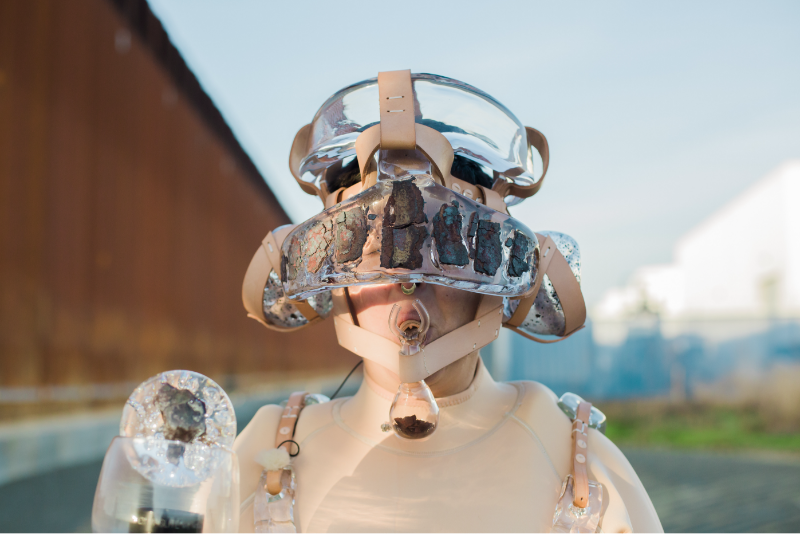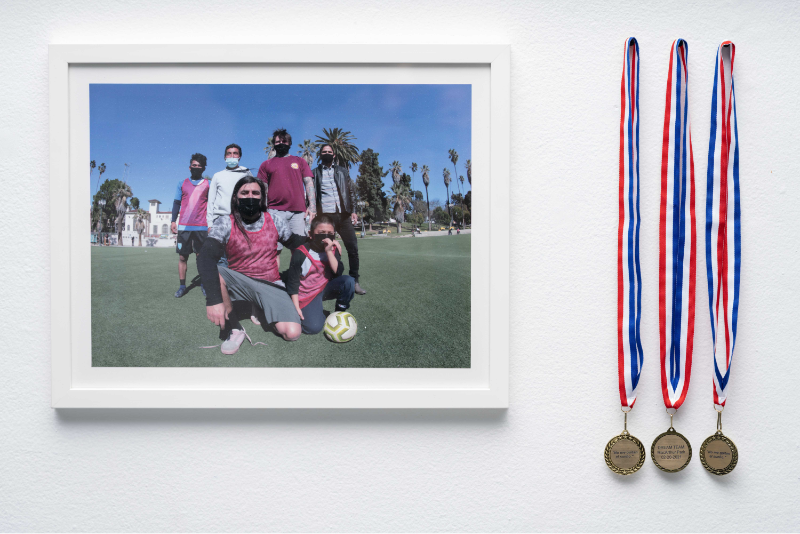Your cart is currently empty!
Intergalactix: against isolation/ contra el aislamiento Los Angeles Contemporary Exhibitions

Step into “Intergalactix: against isolation/contra el aislamiento” at Los Angeles Contemporary Exhibitions (LACE) and the first thing you’ll see is a largish, flattish, squarish stone smack in the middle of a white-walled room decked with wicker beds of tenon sculptures and wisps of fake vegetation. This is Objeto Antiguo, a near-replica of a real Mayan altar stone dating back to 200–900 C.E. The real deal still exists, but it’s far away (in this case, a guy’s backyard in rural Guatemala). That vast distance, between the two stones’ locations as well as the dates of their origins, is precisely curator Daniela Lieja Quintanar’s point.
The past is still with us, the piece suggests. Still active. Still sacred. Still folded into everyday life. Wander over to a stack of printed booklets beside the reception desk, and you can read about Objeto Antiguo in the indigenous Kaqchikel language. You can even cut out a miniature version from the booklet’s pages and assemble it like a paper doll. The DIY context charges Objeto Antiguo as a touchstone of sorts, linking peoples across the slippery, invisible borders dividing the present from the past.
Borders make up the theme of this challenging group exhibition, the product of more than four years of research. Drawing largely from art collectives collaborating across a constellation of disciplines (performance, photography, video, sculpture), “Intergalactix” (the title is lifted from the Zapatista Army’s call for an all-planetary, coalition-building “Encuentro Intergaláctico” or “Intergalactic Gathering” in Chiapas to eradicate neoliberalism in 1996) uses this event as a launchpad to critique the isolation and violence that borders have inflicted on migrants throughout the American continent. Physical borders, conceptual borders, temporal borders; you name it. Borders with a capital “B.”

Shifting the exhibition’s conceptual fulcrum to a largely Indigenous experience was intentional for Quintanar: a means of decolonizing her knowledge, she says. Here in Los Angeles, it’s the US-Mexico border that often first comes to mind. This isn’t to diminish its importance to the exhibition. In Metabolizing the Border (2020), Tijuana-raised, Los Angeles-based artist Tanya Aguiñiga dons a Sonoran-hued neoprene bodysuit and armors herself in surreal, anatomically-inspired objects made of hand-blown glass––headgear, footwear, hollow yokes filled with water, a mouthpiece flecked with corroded fragments of the infamous wall––to ceremonially tread the border’s length. The post-apocalyptic camp of her getup calls out the extreme, even extraterrestrial perils that the journey entails.
As you move deeper into the gallery, the borders sink southward, and you start to realize that their impact on the North American diaspora is more complex than the view from 150 miles away. After all, most migrants to the United States have crossed other borders before. At first glance, the varied colors and textures of the soils showcased in Melissa Guevara’s map of the Americas, Testimonies of the paths that marked the flight (2020–21), seems to hammer in the basic point that no two borders are alike. Study it longer, and you notice that the nations that see the most border crossings are artificially swollen in size, subtly distorting the map’s scale.
Nor are all border crossings equal. Moving southwards is much easier than moving northwards, El Salvadoran artist Crack Rodriguez points out in They don’t take my dream (2021), a happening-qua pick-up-soccer game played on the astroturf field in MacArthur Park. That piece of turf, already known for being uneven, isn’t the only way that Rodriguez toys with the game’s rules. One team has seven players. The other has six. One side can score into a standard soccer goal. The other has to make do with a slim opening between the ground and a felled basketball hoop. In Dream Team (2021), the accompanying installation, Rodriguez displays both goals, netted with hand-hewn webs of twine and feathers, as a caustic reminder that “shooting a dream” has slimmer chances of success when shooting in a northern direction.
“Intergalactix” delights in this kind of highly collaborative, multi-disciplinary, boundary-pushing social commentary, a curatorial outlook that’s very much in LACE’s wheelhouse. Yet Quintanar pays homage to the gallery’s history in more ways than one. The exhibition terminates in the so-called Intergalactix Station, where a display of slides and photographs link the exhibition to antecedents in the gallery’s past. You can learn about an interdisciplinary performance about undocumented migrations to Los Angeles organized in 1991. You can also learn about a multimedia labyrinth depicting life in war-torn El Salvador staged in 1981. You may end up leaving “Intergalactix” with a fleeting realization similar to the one you had when you first saw that Mayan altar stone: a glimpse of peoples from all time periods, around the world, who’ve likely never met, yet are fighting for the same things.